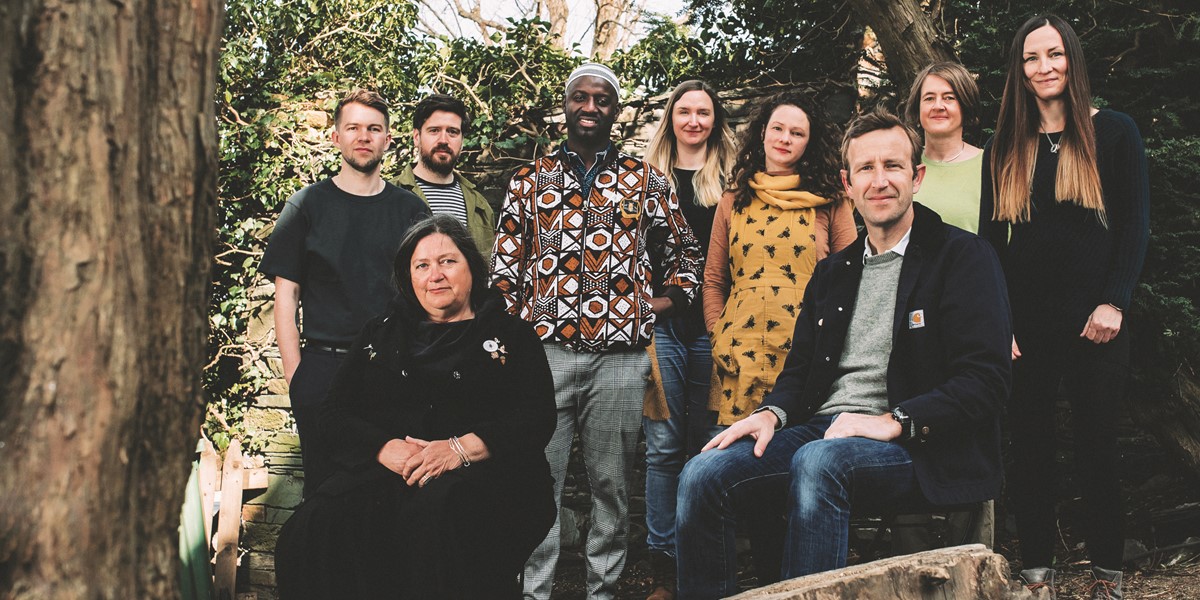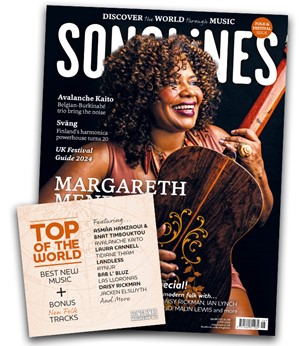Tuesday, January 25, 2022
Spell Songs: Eclectic Light Orchestra
By Tim Cumming
Catching up with the stellar folk collective who are casting their illuminating charms on a world in need of a little magic

Spell Songs (L to R): Jim Molyneux, Jackie Morris, Kris Drever, Seckou Keita, Rachel Newton, Beth Porter, Robert Macfarlane, Karine Polwart and Julie Fowlis
Words are like clay. Each new generation shapes them to their own wants and needs, fires them, fills them and sometime loses them. But where are the words that hold the fear that the next new generation may be among humanity’s last? What shape of spell can be cast against rising sea levels, the loss of habitats, mass extinction?
Robert Macfarlane’s books on landscape, language, nature and our place within it have made him a leading voice on our relationships with the environment, and it was his 2017 book with artist Jackie Morris, The Lost Words, that engendered the first round of the Spell Songs project, recorded at Monmouth’s bucolic live-in Rockfield Studios before its live debut at Folk by the Oak in the summer of 2019. The album and the book, initially a response to the Oxford Junior Dictionary jettisoning dozens of words describing and containing the natural world (such as acorn, blackberry, bluebell, conker, kingfisher), combined live music with live art to cast long spells to bring those words back and refire their clays.

Robert Macfarlane & Jackie Morris
That was then. We’ve had a pandemic and a fury of wildfires and floods globally to recalibrate nature, humanness, our place in it and its place in us. Some of those lost words have been found again as lockdown rooted us to our immediate locales, and from April through to summer stirrings at Coleridge’s old manor at Greta Hall in Keswick and Real World Studios means a second round of Spell Songs is coming, but, crucially, the subtitle of this volume is not about what is lost, but what inspires.
Spell Songs II: Let the Light In features seven of the eight original musicians – Karine Polwart, Julie Fowlis, Seckou Keita, Kris Drever, Rachel Newton, Beth Porter and Jim Molyneux, bar Kerry Andrews, due to health issues – with Macfarlane and Morris creating new spells and paintings, but driven more by the spell craft of hope rather than despair, whose cup runneth over. “There are lots of necessarily bleak conversations going on,” says Drever, whose songs in Spell Songs II include ‘Oak’, ‘Red is Your Art’ (a red fox spell) and ‘Curlew’. “But you do need some lightness, something to lift you up sometimes. And we hope that some of the music will illuminate the fact that there is hope.”
“It’s an echo of the famous Leonard Cohen line, ‘there is a crack, a crack in everything / that’s how the light gets in’,” adds Macfarlane. We are talking, remotely, around the virtual campfire that is Zoom – that emblem of our times. Soon, Julie Fowlis will join us. Drever talks of Joe Biden snarling up the traffic in a 20-car motorcade on his street in Glasgow for the COP26 drive-by. “That sense of voices raised in song and protest and celebration is the light,” continues Macfarlane. “We finished the album as the first cracks of light were beginning to seep through the pandemic, and now it’s coming out as COP26 and the world wrestles with these problems. It feels very alive to the times.”
Spell craft has an ancient history, tied up in the story of human language. Spells were formulae, their purposes to bind an object, a person and their fate. They were spoken and written, fired in clay, taken and broken. They could be curses or appeals. It is a craft that has not gone away. At Knowlton Church and Earthworks in Dorset you’ll find thousands of red ribbons fastened to the branches of the remaining ancient yews. It’s important that we are invested enough to think these anonymous spells and tributes will work their magic when we’ve written them, spoken them, displayed them.

Spell Songs' live debut at Folk by the Oak festival in 2019
As the seven musicians, writer and artist gathered earlier this year in the library of Greta Hall, what new spells in song came to them, and what powers do they impart, and are given by the songs built around each spell like a nest? “A lot of the big ideas happened in Coleridge’s library,” says Drever. “Things came very easily there. And the spaces we were in sounded beautiful, so nothing was forced. There was music happening as soon as the cases were opened.” Macfarlane adds, “the speed of the alchemy was staggering. All that pent-up longing to make music together – I was astounded by how quickly songs would take shape in the air. I’ve never seen creativity happening as intensely and as quickly before.”
Macfarlane was on hand for on-the-spot writing sessions as the spells on the page became songs in the air, and Morris’ art proved a crucial ensemble member too. “She is central to the process,” says Macfarlane. “Kris and the others would sit looking at Jackie’s art and respond musically to it. And she’d give these incredible nudges on the tiller. As a way was being made with the song, she’d say or draw something that altered the course.”
Karine Polwart, too, felt spells were being cast by coming together in one room. “It was sort of like having gold dust sprinkled on you,” she remembers. “All of us had been trying to maintain collaborations and connections in a COVID-safe way, but there’s no alternative to sitting in a room hearing the sound of someone’s voice or instrument resonate in your body. There’s nothing, nothing like that. It was at the end of April, and things were still weird at that point. The whole thing was mythic in its genesis. And the weather was immaculate. It couldn’t have been more pristine.”
As in the first Spell Songs, while each band member takes possession of a spell, ownership is communal. “They’re more collaborative than they seem,” says Drever. “You can guarantee everyone involved had significant input on every piece.” One of the Polwart-led spells, ‘Bramble’, was “written long before lockdown, but very prescient, the idea of the whole world stopping,” she muses. ‘Thrift’, in praise of the hardy perennial of craggy islands and clifftops, comes with a verse in Mandinka from kora player and singer Seckou Keita. Seckou worked with Drever, too, on the likes of ‘Oak’, whose gestation is a good example of how these new Spell Songs assumed their final forms. “There are various mantra passages in the poem itself that reminded me of the songs that pass through playgrounds,” says Drever. “When I looked at Jackie’s work for the ‘Oak’ poem, I inhabited an old space musically, thinking of pipe music, and this little tune came out of that. I set one of those mantras to that, and it grew from there.”
“Then we had a writing session outside for ‘Oak’,” recalls Macfarlane, “thinking of all the things it is – the chair, the frame of the house, the haft of the axe that felled the oak, it’s the coffin, the sleepers on the railway, and the Hunningham oak that had been felled to make way for HS2. And I said, this is a protest poem about the patience of trees and the impatience of people.”
Listening to the finished album, which they’ll be touring in the new year with a launch gig in Glasgow at Celtic Connections in January, you feel that the individual musicians who came together to make the first one are, on the second, a proper band rather than a curated ensemble. “It was already a very joyful and easeful process,” says Polwart of The Lost Words, “but with Let the Light In, we have a better sense of what each other’s strengths are.”
“We all knew what we sounded like,” adds Fowlis when she joins the Zoom call. “I could imagine us when I thought of melodies. I could hear what we could all collectively and individually bring.” Her lead songs include ‘Bird of the Blizzard’ – the snow bunting – and one much older Gaelic-language spell from the folk tradition, ‘St Kilda Wren’, which flows on from Polwart’s opening ‘Bramble’. “‘Bird of the Blizzard’ wasn’t a spell song, but it felt like it absolutely belonged there,” says Fowlis. “I think us musicians are drawn to not just certain words but certain colours and images, and I don’t want to be seen as the ice queen of the group but I was drawn to the sea and the air and the snow and the ice.” The melody came to her, she says, as snow returned to the hills near her home last winter.
“It’s like watching gifts being passed, as a non-musician watching music being made,” says Macfarlane of the musicians’ creative process, from composing in the Greta Hall library through recording at Real World to performing on the stage. “It’s remarkable to me. These great aerial structures made out of the most delicate substances… I just have no idea how they weave it together.” Drever mentions American folk singer Anaïs Mitchell’s quote about the process being “one artist passing the holy water to the next.” “But when seven are doing that simultaneously,” adds Macfarlane, “it’s a cat’s cradle of holy water.”
And so it goes out into the world, with all its delicacy and resilience, to cast spells upon a planet emerging – we hope – from its own darkness, looking for the light.
Spell Songs launch their UK tour on January 27 at Celtic Connections in Glasgow, see here for all dates
Read the review of Spell Songs II: Let the Light In in the Songlines Reviews Database
This article originally appeared in the January/February 2022 issue of Songlines magazine. Never miss an issue – subscribe today

